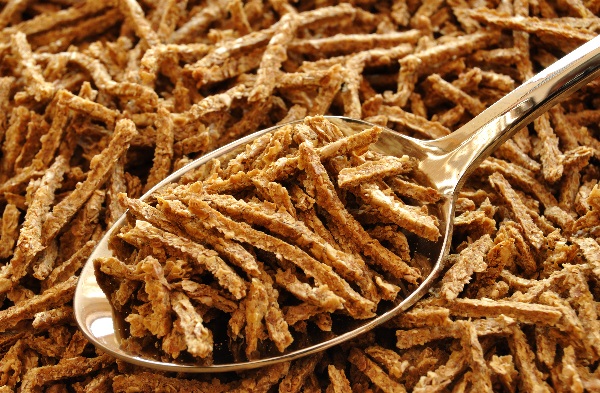1 – Spinach
Spinach is an incredible vegetable – it’s chockfull of beneficial nutrients, such as calcium, magnesium, vitamin C and vitamin K. The truth is we could all do with upping our intake of this leafy green food, however, while spinach is an excellent vegetable, it does contain oxalate.
Oxalate is a naturally occurring acid that is often found in many plant-based foods, such as nuts, seeds and some leafy greens like spinach. Your body can also produce oxalate on its own – in fact, sometimes vitamin C can be converted into oxalate when it is metabolised!1 However, the main concern with oxalate is that it can attach itself to certain minerals and hinder their absorption within your body.
Spinach, for example, has a high content of calcium but, since it also contains oxalate, this content of calcium is not readily absorbed by the body. The good news is that oxalate only affects how the calcium in spinach is absorbed. If you ate spinach alongside another calcium-rich food, such as kale, the calcium content in kale would not be affected or inhibited.
My thoughts: Spinach isn’t just a good source of calcium, it also contains other bone-boosting minerals like magnesium, so I definitely wouldn’t recommend excluding this leafy green vegetable from your diet. Instead, if you are going to eat spinach, make sure you it alongside other calcium-rich foods, such as oily fish, broccoli or chia seeds.
2 – Caffeine
Caffeine may not be the most surprising entrant on this list but it’s still a worthy addition, especially given our collective reliance on beverages such as tea and coffee to push us through our hectic schedules. Caffeine primarily acts as a stimulant, designed to increase your alertness so you feel more awake.
However, if your caffeine intake is too high, it can have a number of negative health repercussions. It can upset your digestive system, sometimes stimulating a bout of diarrhoea, and it can increase your levels of stomach acid. It can also inhibit how you absorb certain minerals, such as magnesium and calcium, which are both essential for healthy bones.

The other problem with caffeine is how long it can linger in your system. The average half-life of caffeine can be anywhere from 4-6 hours2 - this is how long it takes to get rid of half of the caffeine in your body, the rest can linger, especially if you are on medication such as the oral contraceptive pill. Not only will this affect your absorption of certain minerals throughout the day, it can also hinder your sleep patterns at night!
My thoughts: The current upper recommended limit for caffeine is 400mg, or around four cups of coffee.3 I certainly wouldn’t recommend going over this limit and sometimes it may be beneficial to moderate your intake or opt for a caffeine-free substitute, such as our Bambu. If you really can’t get through your day without a cuppa, try to keep your intake to the morning – this should help to ensure that your sleep patterns won’t be disturbed.
3 – Legumes
Legumes are a food group that include a range of beans, from pinto beans to navy beans. Usually these high fibre foods make for a welcome addition to your diet, containing a whole host of nutrients, from magnesium to potassium, however they also contain high levels of phytates.
Phytates are antioxidant compounds, so they can be very useful when it comes to combatting free-radical molecules and oxidative stress, a common culprit when it comes to premature ageing. However, phytates, similar to oxalate, can bind to certain minerals, such as zinc and calcium, which may hinder their absorption.
My thoughts: As part of a balanced diet, there’s nothing wrong with consuming beans. They’re loaded with health benefits and problems only usually arise if they are consumed in excess. Those on restricted diets such as vegetarianism or veganism may need to keep an eye out. However, you can reduce the phytate levels in beans by soaking them in water for a few hours and then cooking them!
4 – Fizzy drinks
If you read my blog, ‘Could fizzy water making you fat?’ you’ll know that here at A.Vogel, we’re not massive fans of fizzy drinks. In moderation, as the occasional treat, there’s nothing wrong with them but the problem is that many of us are consuming these types of drinks on a daily basis.

Not only does research indicate that regularly drinking fizzy drinks can increase your levels of ghrelin, the hunger hormone, most fizzy drinks contain phosphoric acid. Amongst these, Coca-Cola is the worst offender, containing not only higher levels of phosphoric acid, but also caffeine! It’s thought that phosphoric acid can, in large enough quantities, leech the calcium from your bones.
One study found that women who regularly drank cola experienced 4% lower bone mineral density in their hips.4
My thoughts: As I mentioned earlier, there is nothing wrong with a fizzy drink as an occasional treat – problems only arise when we consume fizzy drinks like lemonade and Coca-Cola in excess. That’s why I’d recommend keeping an eye on your intake – remember, these types of drinks won’t keep you hydrated either!
5 – Salty foods
There are a whole plethora of reasons why too many salty foods can be detrimental to your health but focusing on calcium, it’s thought that salt, or sodium, can play a role in reducing your intake of calcium. This is because when your kidneys try to flush the excess sodium from your body, it also excretes calcium at the same time.5 The more salt you consume, the more calcium gets flushed from your body, weakening the integrity of your bones.
My thoughts: Salt can linger in unexpected places – most of you are probably aware that crisps and processed meats contain heaps of salt, but so do unexpected food items such as some pasta sauces, bread, cakes, doughnuts, cheese and even vegetable juices! I’m a big advocate of being label savvy – being aware of what is in your food can go a long ways towards protecting you from any unwanted ingredients or nasty chemical extras. The fewer ingredients, the better!
6 – Wheat bran
Kick-starting your day with a high fibre wheat bran breakfast cereal probably seems like one of the healthier choices and, in most cases, it is. Wheat bran is high in fibre to support your digestive system, and it usually contains a decent amount of energy-boosting B vitamins too! However, like legumes, wheat bran is also high in phytates.

According to the National Osteoporosis Foundation, 100% wheat bran appears to reduce the absorption of calcium in other foods eaten alongside it.6 So if you have your wheat bran alongside milk, it pay prevent your body from being able to utilise the calcium present in milk.
My thoughts: Wheat bran is generally a healthy option so I wouldn’t recommend completely cutting it out from your diet, especially as 100% wheat bran is the big concern. Instead, if you are going to boost your diet with calcium rich foods, try to eat them a few hours after having your wheat bran so their absorption won’t be inhibited.
1https://www.healthline.com/nutrition/oxalate-good-or-bad#section2
2https://www.caffeineinformer.com/caffeine-metabolism
4https://www.webmd.com/osteoporosis/features/soda-osteoporosis#1
5https://www.foodnavigator.com/Article/2012/07/25/Too-much-salt-could-mean-to-too-little-calcium





 Looking for our products in a store near you?
Looking for our products in a store near you?
